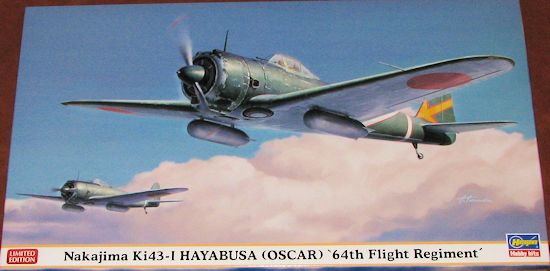
Hasegawa 1/48 Ki-43-I '64th Flight Regiment'
| KIT #: | 07303 |
| PRICE: | $20.70 on sale (44.99 SRP ) |
| DECALS: | Three options |
| REVIEWER: | Scott Van Aken |
| NOTES: | 2012 boxing |

| HISTORY |
The Ki-43 Hayabusa was the Japanese Army Air Forces' equivalent of the Navy's A6M Zero. It as the first fighter with retractable landing gear in the service and was built with maneuverability and range as its main requirements. Its armament was pathetic with twin 7.7mm machine guns and it had almost no armor protection for either the pilot or fuel systems. Against an inferior enemy, like the Chinese, the plane was a terror. Against a better equipped adversary, it didn't fare quite as well.
The initial aircraft were in squadron service when the Pacific war broke out and they were quickly sent to Southeast Asia where they participated in the fight against the Allies in Burma and southern China. They were also found in the Dutch East Indies and New Guinea. While they were quite successful against Allied aircraft and their inexperienced pilots, by mid 1943 when better planes were available for the Allies, the Ki-43 began to show its deficiencies.
However, many JAAF aces flew the Ki-43 and it was modified throughout the war, though it never was able to reach parity with Allied types. It was decided to code name these planes in the 1942/43 time period as most Allied pilots didn't know what Japanese planes were called. Interestingly, all these planes were given 'hill-billy' US names like Zeke, Claude, Topsy, Pete and so forth. Never a Tom. or John, or David. The Ki-43 was code named Oscar, though throughout the war, like most Japanese fighters, it was simply referred to as a Zero!
| THE KIT |
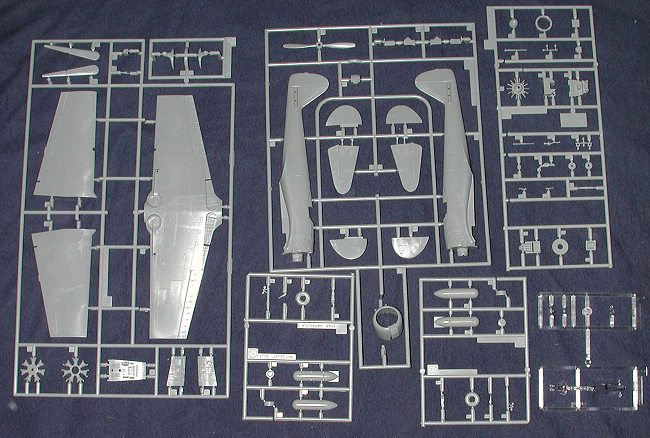 This
is one of Hasegawa's staple kits along with the newer tooled A6M, J2M, Ki-44 and
Ki-84. All of these were done within a few years of each other and as such are
quite similar in their look and detail level.
This
is one of Hasegawa's staple kits along with the newer tooled A6M, J2M, Ki-44 and
Ki-84. All of these were done within a few years of each other and as such are
quite similar in their look and detail level.
The first thing you see is that the wing tips are separate. This is to allow the later model Ki-43s with their longer wings to be done using one sprue for the wings. This means that the tips of the ailerons will have to be filled and sanded as the tips cut through them. I would seem to me that offering separate ailerons would have eliminated this need, but Hasegawa chose this method.
 Like the Ki-84 and newer mold A6M,
the detailing is just superb. For most builders, aftermarket is really not
required. Unlike the Ki-84, you don't have a lot of
separate knobs and buttons in the cockpit. I recall that there were as many as
15-20 parts to the Frank cockpit and this one only has 9 and that includes the
sidewalls.
Like the Ki-84 and newer mold A6M,
the detailing is just superb. For most builders, aftermarket is really not
required. Unlike the Ki-84, you don't have a lot of
separate knobs and buttons in the cockpit. I recall that there were as many as
15-20 parts to the Frank cockpit and this one only has 9 and that includes the
sidewalls.
Thankfully, the only 'plug ins' are the prop and the tail wheel. This makes for a much sturdier construction. The aft part of the prop spinner is an interesting construct as it comes in two parts, trapping the prop between them. The forward part is a separate piece. This should help with painting if you have a two color spinner.
The tires are already flattened and not bulged. You also get a pair of drop
tanks should you wish them. The canopy can be displayed open, which is quite
nice. Also separate are the underfuselage 'butterfly'
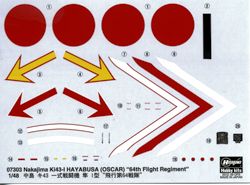 maneuvering flaps. These
slid back to increase the area of the wing and therefore increase
maneuverability. However, I must mention that looking at several dozen images of
Oscars on the ground, I did not once see these deployed.
maneuvering flaps. These
slid back to increase the area of the wing and therefore increase
maneuverability. However, I must mention that looking at several dozen images of
Oscars on the ground, I did not once see these deployed.
Instructions are typically excellent and give Gunze Paint matches. There are decals for three aircraft of the 64th Sentai, all from the early 1942 time frame and all in Nakajima Dark Green uppers with Grey Green undersides. They are all listed by who flew the plane and they differ only in the tail arrow and the stripes that were applied to the fuselage. The decals themselves are very nicely done and are the more modern ones where the white is actually white.
| CONCLUSIONS |
I dare say that there are few 1/48 Japanese WWII fans who have not build this kit in one of its earlier guises. As the king of limited release kits, this variant has probably been boxed a half dozen or more times. The kit is a very nice one and I know I've done a couple of these early planes myself and would have no qualms about doing another in the near future.
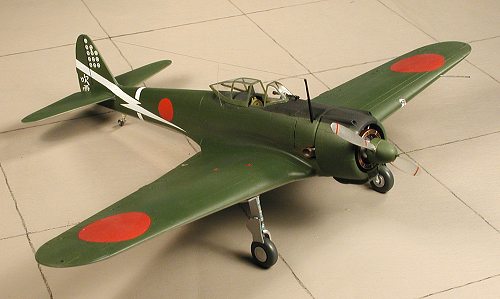
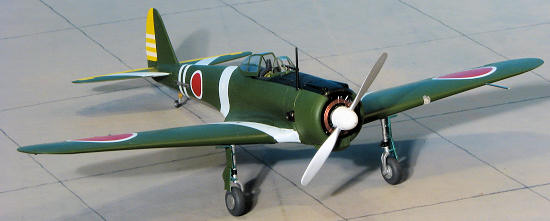
August 2013
Thanks to me for picking this one up on sale
If you would like your product reviewed fairly and fairly quickly, please contact the editor or see other details in the Note to Contributors.